 By JODY BENSON
By JODY BENSONI lean against the logs of the east wall of Fuller Lodge with my paper-plated piece of anniversary cake and watch the so-many-people who are there for the celebration of the Lab’s 75th anniversary.
Next to me, also leaning, is a life-sized cardboard WAC smiling sort-of shyly in her army uniform with that weird little hat that looks like a folded napkin that we ARCOA girls refused to wear with our Red Cross uniforms in Korea and Vietnam.
She’s young, this WAC, and she might never in the rest of her life participate in such a world-changing event as what she is doing at Project Y.
I bet she knows how important the work is—even if she doesn’t know what the work is. But within the restrictions imposed by secrecy and location, all the inconvenient isolation and shortages from housing to sanitary products, she’s part of the complex system supporting what she intuits will be something never ever seen before.
She and I both watch the crowds on the east lawn. The WAC would remember a different space hurrying with people—badged men in suits rushing inside to grab lunch, a couple scientists with heads together gesticulating in the shade of the old poplar trees. She would breathe the dust of the dirt road where MPs, caps pulled down against the sun, lounge against their jeeps, and beyond, she would see the organic shape of the Pond with its sway of cattails and an off-duty soldier paddling one of the remaining Ranch School canoes.
Our WAC wouldn’t see many kids. Not in 1943. She would’ve seen bulldozers roaring aside the clay soil to plow streets along which contractors would slap up wooden firetrap buildings for Lab space and eventually Sundts, Morganville and McKeeville housing for families the scientists insisted must accompany them. And everything everywhere is rolled up in barbwire.
She would look out and see young people. Everybody’s young. Everybody’s energetic. She wouldn’t know—at her age, how could she?—that 75 years later, her whole history has been lived, and her life is now part of the history today’s celebration celebrates. If she’s still alive, she’s in her 90s. But as part of history, the woman I stand beside today is shy, young, 20-something, a participant in her own important present, still with years of future ahead of her.
Standing next to her I see my layer of history that’s just beyond hers. The Lodge lawn would still be—for a couple years—the center of a government town, but now with nice housing, albeit assigned, and families boomed with babies. I’d be prowling unfettered with my playmates, while moms with baby carriages head into the little bakery next to the Sears store in the central shopping center, and Zia guys (most workers are men) tend the facilities or drive trucks along the narrow, pitted-but-paved streets. The only older people are visitors. Old people have no place here. In my strata, LAHS students, many the children of famous scientists, assume that every class will graduate a future Nobel Laureate.
Today, 60 years later, the people on the lawn are multigenerational with surprisingly few of the over-50 crowd that occupies most of the current Los Alamos demographic. The crowds contain kids: lots of toddlers in sun hats, some being consoled out of their crankiness by parents waiting for a burger or the bus, teenagers hanging out in their sloganed t-shirts or pink hair….
Soon those toddlers dropping their piece of cake from the paper plate to the lawn, will be in high school like the bored teenagers slouching around and dreaming of when they can leave this nothing-to-do town. Maybe, if there’s still science in America, they’ll be back to work at the Lab. But already, even as kids, they have established their own strata of experience. What they see in 75 years will be as different as what the shy, young WAC is looking at as she faces east across the lawn, past the Big House, past the pastures and former fields, toward the Sangres in a secret site in an unpopulated state.
History is memory. History is also the future. For the WAC and me, we’ve already historialized our futures. We’ve laid down the stratigraphy of our events. (I admit—her generation did a better job at future history than mine.) But something about this place—about Fuller Lodge and the hill it’s on and the water in the Pond, the streets, houses, businesses, parking lots, trees, signs, slogans—is that this actual, physical place embodies its own memory. This place lets us walk with ghosts, dead in this future, but still young in this place. Now-young families with their toddlers and teens set their feet on the grass and sidewalks, and the place remembers them. It’s no longer just The Bomb. Theirs are the new ideas energizing our history.
The WAC and I watch the celebration and think of their future—our new history. I glance toward her. I know that even shy she, with her face expressing a 75-years-ago single moment, is excited about what these people will create. I lift my plate of cake in salute, and she, I’m sure of it, winks back.

